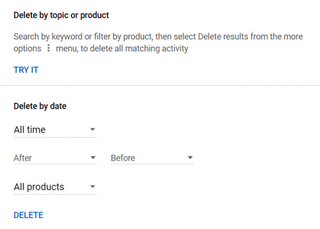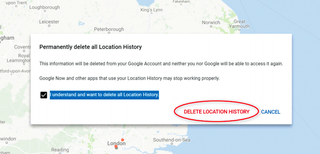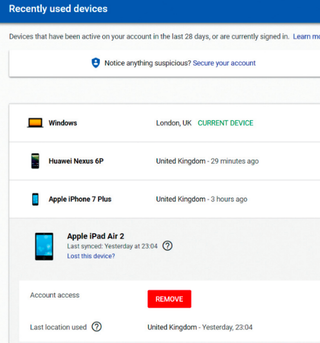What Google knows about you
Google knows where you've been, and that's just the tip of a privacy-invading iceberg

Google is well-known for tracking information about its users and it's not really surprising - after all - it is the largest search engine and the biggest advertising platform around (although Facebook is making a concerted effort to take that crown for itself).
This data that Google collects whenever you visit a website, make a purchase or even search for something is how it makes its money. It uses this information to target you with relevant ads, learning more about your interests every single time you open your browser. It's also this information that funds the services it offers for free, such as Gmail and Google Drive (along as you're using its 15GB package).
Google is pretty open about its data collection methods in its privacy policy and it has to be to remain legal, giving you the option to opt out of your journey being tracked. The relevant statement says: "we use the information we collect from all of our services to provide, maintain, protect and improve them, to develop new ones and to protect Google and our users."
But privacy is still a pretty big issue and Google has tried to address this by providing more transparency about why it's collecting all this data. Users are free to view and control the information it holds about them, but it's not made a particularly easy job, with the tech giant scattering the settings around different pages in its settings menu, on your phone, tablet and computer.
In this section, we'll point you straight at the Google settings you need to change if you don't want to have your web activity tracked.

Your search and web activity
You probably won't be too shocked by the fact that Google stores and uses data from your web searches. Even still, viewing everything the company has recorded about your web activities (by signing in with your Google account) is quite an eye-opener.
Your activity is shown as a vertical timeline and, depending on how many Google-related tools, services and devices you use, you could be presented with a list of not only every Google search you've performed, but also every site you've visited in Chrome, every route you've planned in Google Maps, every Android app you've ever used and more besides, all stretching back years.
Get the ITPro. daily newsletter
Receive our latest news, industry updates, featured resources and more. Sign up today to receive our FREE report on AI cyber crime & security - newly updated for 2024.

Erase your Google search history by choosing the date range, then clicking delete
Thankfully, My Activity lets you control how much of this data Google stores. You can search for specific items or scroll back through your history to find something you want to delete. Click an item for more details, then click the three vertical dots button in the pop-up windows and click Delete, then click Delete again to remove the item from your history.
Alternatively, you can delete data in bulk by clicking the three vertical dots button in the top right-hand corner of the main page and selecting 'Delete activity by'. Here, you can select the date range and the Google service (Search, for example) you want to delete data for from the drop-down menus, and click Delete, then Delete again. Or, if you want to get rid of the whole lot, select 'All time' and 'All products' from the menus.
To stop Google tracking your searches (and your browsing activity if you use Chrome), head here, turn off the blue slider, then click Pause.
Your location history
Google keeps track of your movements in the real world, as well as the online one. It follows you when you're signed into your Google account, and you're carrying your phone or tablet at the same time.
You can view your location history by signing into your Timeline. Select a date from the drop-down menus in the top left corner.
To stop Google tracking your location click the Pause Location History button at the bottom of the page, then click Pause in the window that pops up. Keep in mind that this won't turn off the built-in location-tracking abilities of any devices you use.
For example, if you use an Android phone, you may also wish to tap Settings, 'Security & location', then Location and either completely switch off 'location tracking', or tap 'App-level permissions' and disable it for individual apps.

Tick this box, then click 'Delete Location History' to permanently erase it
Disabling location tracking won't delete any previous location activity that Google has recorded. To do this, click the small dustbin icon to the lower right of the Timeline page's main map image. In the window that appears, tick the box next to 'I understand and want to delete all Location History', then click Delete Location History. This will permanently delete your location history - neither you nor Google will be able to get it back.
Bear in mind that disabling location tracking and deleting your location history may affect the functions of some Google services. For example, Google Now, which answers your spoken queries, will no longer be able to provide you with information or suggestions based on your location.

Your personal interests
Rather creepily, Google builds a list of things you like (and don't like), based on your search and YouTube activity. It uses this to create a profile that lets advertisers target you. Google claims this is to "make the ads that you see more useful to you".

Disable personalisation adverts by clicking the blue slider, then selecting Turn Off
To see what Google thinks your interests are, head here and sign in with your Google account. Scroll down to the 'Topics you like' and 'Topics you don't like' headings. You may find these are eerily accurate. You can click the X to delete individual likes and dislikes, and add new ones (click '+New Topic'), should you wish.
Alternatively, you can completely turn off targeted advertising by clicking the blue slider to the right of the Ads Personalisation heading, then clicking Turn Off.
Your gender and birthday
Like many sites and services, Google asks for sensitive details - including your age and gender - when you sign up for an account. The difference is that Google may share some of this information openly, unless you tell it not to.
Head here and look under 'Gender, date of birth and more'. If you see a green globe icon next to any of the information shown here, that means it's shared publicly - anyone can see it when they look at your Google profile.

Select 'Private' to stop people seeing personal info on your Google profile
To change this, click the globe icon and select Private. Even then, Google will continue to use your gender information to "provide more relevant, tailored content you might be interested in, like ads" unless you change yet another setting.
Go to this page and scroll down to 'Your profile'. Click the pencil icon next to Gender and select 'Rather not say'. Be aware that choosing this will also stop Google tools and services from referring to you as either male or female.
Your voice
If you use the Google Now assistant, or any of the company's Home smart speaker products, then recordings of your voice may also be among the data stored about you on Google's giant servers.
Like most voice-controlled assistants, Google Now and Google Home work by learning and accessing all kinds of personal data, so you should avoid using them if you want to avoid Google's tentacles. Deleting or blocking access to your data effectively renders them next to useless.
To check for and delete any existing voice recordings Google might have, head here and click in the Search box at the top. Make sure 'All time' is selected under 'Filter by date', then untick 'All products', tick 'Voice & Audio' and click the Search (magnifying glass) icon. Click the three dots button in the Search box, then click 'Delete results', Delete.

Your devices

Remove devices from Google's history so it no longer knows what you use
As well as tracking you and your activities, Google likes to keep a record of the devices you've used to access its services - not just Android devices but Windows PCs, iPhones and more. It might be less invasive than some of the other data the company keeps on you, but you may still wish to delete devices you no longer use - if you've lost your phone and you want to block access to your Google account from it, for example.
To do so, sign in here, then click 'Device activity & security events' on the left. Now click Review Devices, click the device you want to delete and click the Remove button.
Image: Shutterstock




